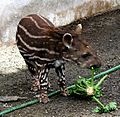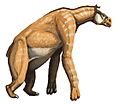Odd-toed ungulate facts for kids
Quick facts for kids Odd-toed ungulatesTemporal range: Late Palaeocene - Recent
|
|
|---|---|
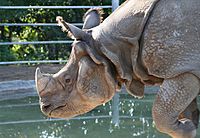 |
|
| Rhinoceros | |
| Scientific classification | |
| Kingdom: | |
| Phylum: | |
| Class: | |
| Infraclass: | |
| Superorder: | |
| Order: |
Perissodactyla
Owen, 1848
|
Odd-toed ungulates are a group of mammals called Perissodactyla. These animals are special because they have an uneven number of toes on their feet. This group includes well-known animals like horses, rhinos, and tapirs. They first appeared on Earth a very long time ago, during the late Palaeocene period.
Contents
What Are Odd-Toed Ungulates?
The name "Perissodactyla" comes from Greek words meaning "odd-toed." This is the main feature that sets them apart from other hoofed animals. For example, horses have only one toe on each foot, which is actually a very strong hoof. Rhinos usually have three toes on each foot. Tapirs are a bit different; they have four toes on their front feet and three toes on their back feet.
These animals walk on their middle toe, which is the largest and strongest. This middle toe carries most of their weight. Their hooves are like thick nails that protect their toes.
Types of Odd-Toed Ungulates
Today, there are three main families of odd-toed ungulates still living. These are the Equidae (horses, zebras, and donkeys), the Rhinocerotidae (rhinos), and the Tapiridae (tapirs). Each family has unique features and lives in different parts of the world.
Horses, Zebras, and Donkeys
The Equidae family includes horses, zebras, and donkeys. These animals are known for their speed and strong legs. They usually live in open grasslands and plains. Wild horses and zebras often live in herds, which helps them stay safe from predators.
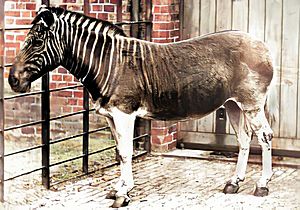
Horses have been very important to humans for thousands of years. We have used them for transport, farming, and sports. Zebras are famous for their black and white stripes, which help them blend in with their surroundings. Donkeys are known for being strong and hardy, often used for carrying heavy loads.
Rhinos: Giants with Horns
The Rhinocerotidae family includes the large, powerful rhinos. These animals are famous for the horn or horns on their snouts. Rhinos are some of the biggest land mammals. They can be found in parts of Africa and Asia.
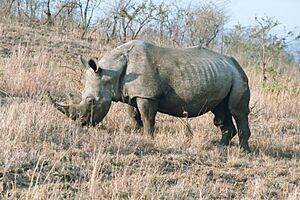
Sadly, many rhino species are in danger of extinction. This is mainly because of habitat loss and poaching (illegal hunting) for their horns. Conservation efforts are working hard to protect these amazing animals.
Tapirs: Forest Dwellers
The Tapiridae family includes tapirs. These animals look a bit like pigs, but they have a short, flexible trunk. This trunk is actually their nose and upper lip, which they use to grab leaves and fruit. Tapirs live in forests, mostly in Central and South America, and one species in Southeast Asia.
Tapirs are shy animals that are often active at night. They are good swimmers and often spend time near water. Like rhinos, some tapir species are also facing threats to their survival due to habitat destruction.
Ancient Odd-Toed Ungulates
The odd-toed ungulate group used to be much larger and more diverse. Many ancient species are now extinct. Scientists learn about these ancient animals from their fossils.
For example, Eohippus was an early relative of the horse. It was much smaller than modern horses, about the size of a fox. It lived millions of years ago. There were also giant rhinos that were much larger than any rhino alive today. Studying these fossils helps us understand how these animals have changed over millions of years.
Images for kids
-
Restriction of their habitat and poaching threaten the survival of most rhino species, including the Indian rhinoceros shown here
-
A young Brazilian tapir
-
Eohippus, an early relative of the horse, is one of the oldest-known perissodactyls
See also
 In Spanish: Perisodáctilos para niños
In Spanish: Perisodáctilos para niños





